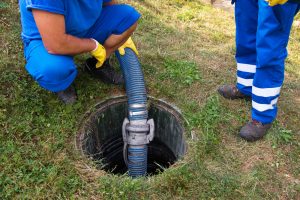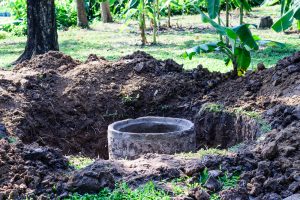Your septic tank is located underground, which means that you can’t see it. While the old adage “out of sight, out of mind” might apply to certain things, when it comes to a septic system, it most certainly doesn’t.

Though you might not be able to see your septic system, it is imperative that you are aware of it and know whether or not it is functioning properly. If you don’t know what’s going on with the system, you could be looking at a very messy, costly, inconvenient, and dangerous problem: an overflow.
While it might seem like an overflow comes out of nowhere, often, the signs that the system is going to backup are there long before it actually does. Being aware of the signs of an overflow will help you spot the problem and treat the underlying cause before it becomes a major issue. If your home or business has a septic tank, below, you will find issues that could cause an overflow that you need to be aware of any signs that your septic system is overflowing.
Ground Movement
Earthquakes may not be a common occurrence on Long Island, but that doesn’t mean the ground isn’t moving. It might not be shaking to the point that you can actually feel it, but the ground is always moving. Eventually, this movement could shift your septic system and put a lot of pressure on the pipes, the tank, or both. This pressure could lead to fractures or cracks in the walls of the tank or the pipes. Should this happen, the risk of an overflow increases, as groundwater could penetrate the septic tank via the cracks or fractures. Additionally, waste from the tank could expel from the cracks and cause groundwater contamination.

Vehicle Damage
Believe it or not, vehicles can actually damage a septic system. Their weight can put excessive pressure on the pipes or the tank itself, causing cracks that could lead to leaks. The pressure also has the potential to collapse the tank.
Roots
Roots from trees and shrubs can do extensive damage to a septic system. They can infiltrate the pipes or the tank, causing cracks that can lead to leaks, as well as blockages; both of which could lead to an overflow.
Faulty Installation or Design
For a septic system to function properly, it has to be properly designed and installed. If you are having a new system installed, make sure you choose a cesspool company with an excellent reputation. A reputable cesspool installer will use the highest quality materials and will properly install the system to reduce the risk of problems, such as an overflow. If cesspool installation is done by a company that has a sub-par reputation, there’s a very good chance that you will encounter problems in the future.
Flushing Hazardous Materials into the Tank
A septic tank can only process organic waste. Flushing items down drains and toilets that are inorganic in nature will increase the likelihood of a backup for several reasons: they could clog the pipes or disrupt the balance of the bacteria that is necessary for breaking down waste.
Examples of items that shouldn’t be put into a septic tank include:
- Grease
- Metal
- Latex
- Plastic
- Wipes
- Feminine hygiene products
- Motor oil
- Cigarette butts
- Paint
- Harsh chemical cleaners
- Diapers
For a complete list of items that shouldn’t be put into a septic tank, contact a cesspool company.
Excessive Water
Septic tanks have a set capacity in terms of the amount of waste they can accommodate. Should your tank be exposed to more water than it is designed to hold, a backup is inevitable. Using too many appliances and fixtures that require drainage at one time will increase the likelihood of an overflow. Additionally, runoff water from rain and melting snow could increase the risk of overflow. Make sure your outdoor drainage systems, such as the gutters, are flowing away from the septic tank and the drain field.
Signs of an Overflow
A septic system overflow is pretty hard to miss. However, if you have never experienced one before, or if you aren’t sure what to look for, here’s a look at some of the most common signs that indicate your septic tank is overflowing:
- Sewage backup. One of the most obvious signs of an overflow is backed up sewage. When a septic tank is full, the waste has nowhere else to go but out. This means sewage could seep out of drains, toilets, and even washing machines and dishwashers.
- A peculiar odor. The smell of raw sewage will accompany an overflow. The smell is unmistakable. At first, you might notice it outside, but as the problem grows worse, the odor can seep out of drains and toilets, too.
- Pooled water. A pool of water around your septic tank is a good indication that the system is overflowing. As the water pushes out of the tank, it can collect in the surrounding area, creating a large and very noticeable puddle.

It’s crucial to understand the causes and signs of an overflowing septic tank. If you suspect that your system is overflowing, you believe there are any issues that could lead to an overflow, or you want to have your system serviced and you are located in the village of Melville, call Long Island Cesspool at (631) 529-2149. Our cesspool company has been servicing the residents and businesses of the village for more than 10 years. We offer a range of services to ensure your system is operating properly. We’re also available 24 hours a day, 7 days a week, so if an emergency strikes on a Sunday afternoon or in the middle of the night, you can count on us to fix the problem. We can easily reach any location in Melville, including residences near Butterfly Park and businesses off of Old Country Road. Our technicians will be at your destination in no time to ensure prompt, reliable, and affordable service.

